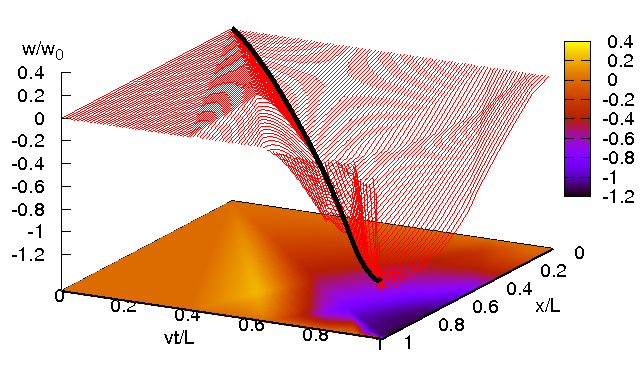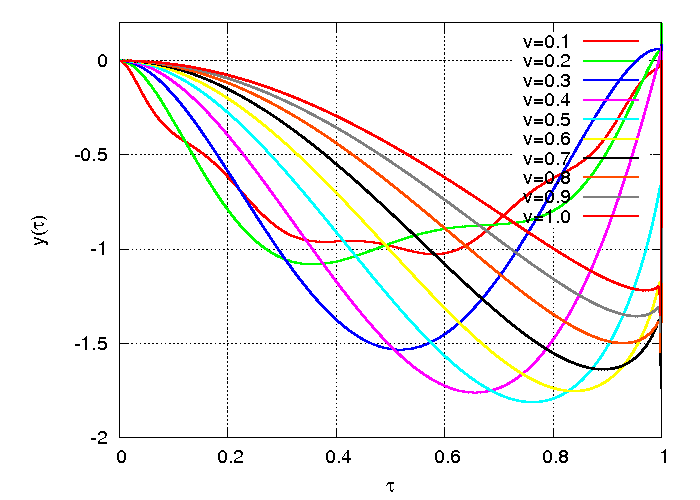Moving load on:
[Wikipedia]
[Google]
[Amazon]
In
 The last term, because of complexity of computations, is often neglected by engineers. The load influence is reduced to the massless load term. Sometimes the oscillator is placed in the contact point. Such approaches are acceptable only in low range of the travelling load velocity. In higher ranges both the amplitude and the frequency of vibrations differ significantly in the case of both types of a load.
The differential equation can be solved in a semi-analytical way only for simple problems. The series determining the solution converges well and 2-3 terms are sufficient in practice. More complex problems can be solved by the
The last term, because of complexity of computations, is often neglected by engineers. The load influence is reduced to the massless load term. Sometimes the oscillator is placed in the contact point. Such approaches are acceptable only in low range of the travelling load velocity. In higher ranges both the amplitude and the frequency of vibrations differ significantly in the case of both types of a load.
The differential equation can be solved in a semi-analytical way only for simple problems. The series determining the solution converges well and 2-3 terms are sufficient in practice. More complex problems can be solved by the 
 :
where st is the static deflection in the middle of
the string.
The solution is given by a sum
:
where is the dimensionless parameters :
:
Parameters , and are given below
:
:
where st is the static deflection in the middle of
the string.
The solution is given by a sum
:
where is the dimensionless parameters :
:
Parameters , and are given below
:
 In the case of =1, the considered problem has a closed solution:
In the case of =1, the considered problem has a closed solution:
structural dynamics
Structural dynamics is a type of structural analysis which covers the behavior of a structure subjected to dynamic (actions having high acceleration) loading. Dynamic loads include people, wind, waves, traffic, earthquakes, and blasts. Any structur ...
, a moving load changes the point at which the load is applied over time. Examples include a vehicle that travels across a bridge and a train moving along a track.
Properties
In computational models, load is usually applied as * a simple massless force, * an oscillator, or * an inertial force (mass and a massless force). Numerous historical reviews of the moving load problem exist. Several publications deal with similar problems. The fundamental monograph is devoted to massless loads. Inertial load in numerical models is described in Unexpected property of differential equations that govern the motion of the mass particle travelling on the string, Timoshenko beam, and Mindlin plate is described in. It is the discontinuity of the mass trajectory near the end of the span (well visible in string at the speed ''v''=0.5''c''). The moving load significantly increases displacements. The critical velocity, at which the growth of displacements is the maximum, must be taken into account in engineering projects. Structures that carry moving loads can have finite dimensions or can be infinite and supported periodically or placed on the elastic foundation. Consider simply supported string of the length ''l'', cross-sectional area ''A'', mass density ρ, tensile force ''N'', subjected to a constant force ''P'' moving with constant velocity ''v''. The motion equation of the string under the moving force has a form : Displacements of any point of the simply supported string is given by the sinus series : where : and the natural circular frequency of the string : In the case of inertial moving load, the analytical solutions are unknown. The equation of motion is increased by the term related to the inertia of the moving load. A concentrated mass ''m'' accompanied by a point force ''P'': : The last term, because of complexity of computations, is often neglected by engineers. The load influence is reduced to the massless load term. Sometimes the oscillator is placed in the contact point. Such approaches are acceptable only in low range of the travelling load velocity. In higher ranges both the amplitude and the frequency of vibrations differ significantly in the case of both types of a load.
The differential equation can be solved in a semi-analytical way only for simple problems. The series determining the solution converges well and 2-3 terms are sufficient in practice. More complex problems can be solved by the
The last term, because of complexity of computations, is often neglected by engineers. The load influence is reduced to the massless load term. Sometimes the oscillator is placed in the contact point. Such approaches are acceptable only in low range of the travelling load velocity. In higher ranges both the amplitude and the frequency of vibrations differ significantly in the case of both types of a load.
The differential equation can be solved in a semi-analytical way only for simple problems. The series determining the solution converges well and 2-3 terms are sufficient in practice. More complex problems can be solved by the finite element method
The finite element method (FEM) is a popular method for numerically solving differential equations arising in engineering and mathematical modeling. Typical problem areas of interest include the traditional fields of structural analysis, heat ...
or space-time finite element method
In physics, spacetime is a mathematical model that combines the three dimensions of space and one dimension of time into a single four-dimensional manifold. Spacetime diagrams can be used to visualize relativistic effects, such as why differen ...
.
The discontinuity of the mass trajectory is also well visible in the Timoshenko beam. High shear stiffness emphasizes the phenomenon.

The Renaudot approach vs. the Yakushev approach
Renaudot approach
:Yakushev approach
:Massless string under moving inertial load
Consider a massless string, which is a particular case of moving inertial load problem. The first to solve the problem was Smith. The analysis will follow the solution of Fryba. Assuming =0, the equation of motion of a string under a moving mass can be put into the following form : We impose simply-supported boundary conditions and zero initial conditions. To solve this equation we use the convolution property. We assume dimensionless displacements of the string and dimensionless time : :
where st is the static deflection in the middle of
the string.
The solution is given by a sum
:
where is the dimensionless parameters :
:
Parameters , and are given below
:
:
where st is the static deflection in the middle of
the string.
The solution is given by a sum
:
where is the dimensionless parameters :
:
Parameters , and are given below
:
 In the case of =1, the considered problem has a closed solution:
In the case of =1, the considered problem has a closed solution:
References